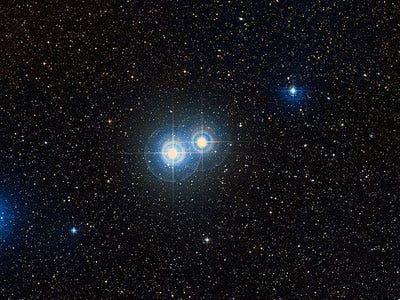In observational astronomy, a double star or visual double is a pair of stars that appear close to each other as viewed from Earth, especially with the aid of optical telescopes.
The first double stars that were found include Mizar and Gamma Arietis. Located in the constellation Ursa Major, the star Mizar was observed to be a double star by Benedetto Castelli and Galileo. After identification of Mizar, other scientists were discovering double stars too, which included Robert Hooke, who discovered one of the first double-star systems, Gamma Arietis, in 1664. Another interesting find was the bright southern star Acrux, in the Southern Cross, was discovered to be double by Fontenay in 1685.
Since their discovery, scientists have developed 3 categories for double stars.
- Optical doubles are unrelated stars that appear close together through chance alignment with Earth.
- Visual binaries are gravitationally-bound stars that are separately visible with a telescope.
- Non-visual binaries are stars whose binary status was deduced through more esoteric means.
There are several instances in which one can see a double star, which are mainly visual and optical doubles.
Visual Doubles
- Acrux
- Alpha Centauri
- Capella
- p Eridani
- Polaris
- Procyon
- Sirius, which is part of the Winter Hexagon
- Alpha Centauri system (AB) and Proxima Centauri (thus α Cen C): Actually a three-star system
Optical Doubles
- Alpha1 and Alpha2 Capricorni
- Theta Muscae and Theta Muscae B
- Eta1 and Eta2 Coronae Australis
- Kappa1 and Kappa2 Coronae Australis
- Winnecke 4, otherwise known as Messier 40

Be the first to comment on "Double Stars"